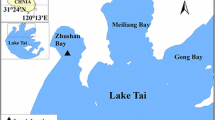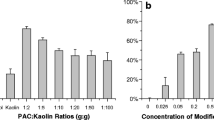Abstract
The dumping of bauxite tailings into Batata Lake, an Amazonian clear-water lake, generated high levels of turbidity and caused a serious decrease in phytoplankton densities, which could possibly be the result of a photosynthetic limitation due to light attenuation together with an increase in algal sinking due to the adhesion of clay particles. This study aimed to investigate the sinking process through the addition of different suspended clay concentrations in columns containing Batata lake water. Since no effect of the suspended clays on Batata Lake phytoplankton sinking was observed, it was then evaluated, under laboratory conditions, whether the low conductivity of the Batata Lake water could interfere with the algae-clay aggregation process. Cultures of two algal species known to be capable to aggregate to Batata Lake suspended clays in algal culture medium: Staurodesmus convergens and Phormidium amoenum, were added to both the low conductivity Batata Lake water (14 μS cm−1) and the high conductivity algal culture media (WC – 300 μS cm−1 and Z8 – 560 μS cm−1) together with Batata lake suspended clays. In both algal culture media and Batata lake water the two species had their sinking accelerated due to clay adhesion. It is thus suggested that the decrease in phytoplankton densities recorded in Batata Lake may not be related to an increase in phytoplankton loss rates due to algal-clay aggregation, but rather are a consequence of decreasing growth rates because of light attenuation.
Similar content being viewed by others
References
Ambühl, H. & H. Buhrer, 1975. Technik der Entnahme ungerstörtern Grossproblen von Seesedimenten; ein verbessertes Bohrlot. Schweizerische Zeitschrift für Hydrologie 37: 175–186.
Avnimelech, Y., B. W. Troeger & L. W. Reed, 1982. Mutual flocculation of algae and clay: evidence and implications. Science 216: 63–65.
Bozelli, R. L., F. A. Esteves & F. Roland, 2000. Lago Batata: Impacto e Recuperação de um Ecossistema Amazônico. Instituto de Biologia, Universidade Federal do Rio de Janeiro / Sociedade Brasileira de Limnologia, Rio de Janeiro, 342 pp.
Bozelli, R. L. & A. V. Garrido, 2000, Gradient of inorganic turbidity and responses of planktonic communities in an Amazonian lake, Brazil. Verhandlungen der Internationale Vereinigung für Limnologie 27: 147–151.
Buckman, H. O. & N. C. Brady, 1960. The Nature and Properties of Soils. Macmillan Publishing Co., Inc., 567 pp.
Cuker, B. E., 1987. Field experiments on the influences of suspended clay and P on the plankton of a small lake. Limnology and Oceanography 32: 840–847.
Cuker, B. E., P. T. Gama & J. M. Burkholder, 1990. Type of suspended clay influences lake productivity and phytoplankton community response to phosphorus loading. Limnology and Oceanography 35: 830–839.
Guilard, R. R. L. & C. J. Lorenzen, 1972. Yellow-green algae with chlorophyllide. Journal of Phycology 8: 10–14.
Holm-Hansen, O. & B. Riemann, 1978. Chlorophyll-a determination: improvement in methodology. Oikos 30: 438–447.
Huszar, V. L. M., 2000. Fitoplâncton. In Bozelli, R. L., F. A. Esteves & F. Roland (eds), Lago Batata: Impacto e Recuperação de um Ecossitema Amazônico. Instituto de Biologia-Universidade Federal do Rio de Janeiro / Sociedade Brasileira de Limnologia, Rio de Janeiro: 89–104.
Huszar, V. L. M. & C. S. Reynolds, 1997. Phytoplankton periodicity and sequences of dominance in an Amazonian flood-plain lake (Lago Batata, Pará, Brazil): responses to gradual environmental change. Hydrobiologia 346: 169–181.
Jackson, G. A., 1990. A model of the formation of marine algal flocs by physical coagulation processes. Deep Sea Research 37: 1197–1211.
Kimmel, B. L., 1983. Size distribution of plankton autotrophy and microheterotrophy: implications for organic carbon flow in reservoir food webs. Archiv für Hydrobiologie 97: 303–319.
Kiorboe, T., K. P. Andersen & H. G. Dam, 1990. Coagulation efficiency and aggregate formation in marine phytoplankton. Marine Biology 107: 235–245.
Kirk, J. T. O., 1985. Effects of suspensoids (turbidity) on penetration of solar radiation in aquatic ecosystems. Hydrobiologia 125: 195–208.
Lapa, R., 2000. A bauxita e o rejeito de bauxita. In Bozelli, R. L., F. A. Esteves & F. Roland (eds.), Lago Batata: Impacto e Recuperação de um Ecossistema Amazônico. Instituto de Biologia, Universidade Federal do Rio de Janeiro / Sociedade Brasileira de Limnologia, Rio de Janeiro: 25–37.
Lind, O. T. & L. Dávalos, 1990. Clay, dissolved organic matter and bacterial interactions in two reservoirs. Archiv für Hydrobiologie Beihefte Ergebnisse der Limnologie 34: 119–125.
Lund, J. W. G., C. Kipling & E. D. Lecren, 1958. The inverted microscope method of estimating algal number and the statistical basis of estimating by counting. Hydrobiologia 11: 143–170.
Neihof, R. A. & G. I. Loeb, 1972. The surface charge of particulate matter in seawater. Limnology and Oceanography 17: 7–16.
Paerl, H. W., 1974. Bacterial uptake of dissolved organic matter in relation to detrital aggregation in marine and freshwater ecosystems. Limnology and Oceanography 19: 966–972.
Panosso, R., 2000. ConsideraçÕes geográficas e geomorfológicas. In Bozelli, R. L., F. A. Esteves & F. Roland (eds), Lago Batata: Impacto e Recuperação de um Ecossitema Amazônico. Instituto de Biologia, Universidade Federal do Rio de Janeiro / Sociedade Brasileira de Limnologia, Rio de Janeiro: 37–55.
Paul, E. A., 1988. Soil Microbiology and Biochemistry. Academic Press, Inc., San Diego, California, 335 pp.
Roland, F. & F. A. Esteves, 1993. Dynamics of phosphorus, carbon and nitrogen in an Amazonian lake impacted by bauxite tailings (Batata Lake, Pará, Brazil). Verhandlungen der Internationale Vereinigung für Limnologie 25: 925–930.
Salati, E. & J. Marques, 1984. Climatology of the Amazon region. In Sioli, H. (ed.), The Amazon: Limnology and Landscape Ecology of a Mighty Tropical River and Its Basin. Dr W. Junk Publishers, Dordrecht: 85–126.
Sioli, H., 1950. Das Wasser im Amazonasgebiet. Forschungen und Fortschritte 26: 274–280.
Soballe, D. M. & S. T. Threlkeld, 1988. Algal-clay flocculation in turbid waters: variations due to algal and mineral differences. Verhandlungen der Internationale Vereinigung für Limnologie 23: 750–754.
Staub, R., 1961. Ernährungsphysiologisch-autökologische Untersuchungen an der plancktonische Blaualge Oscillatoria rubescens DC. Schweizerische Zeitschrift für Hydrologie 23: 82–198.
Uhelinger, V., 1964. Étude statistique des méthodes de dénombrement planctonique. Archives des Sciences 17: 121–223.
Utermöhl, H., 1958. Zur Vervollkomnung der quantitativen Phytoplankton-Methodik. Mitteilungen der Internationale Vereinigung theoretische ung angewandte Limnologie 9: 1–38.
Author information
Authors and Affiliations
Rights and permissions
About this article
Cite this article
Guenther, M., Bozelli, R. Effects of Inorganic Turbidity on the Phytoplankton of an Amazonian Lake Impacted by Bauxite Tailings. Hydrobiologia 511, 151–159 (2004). https://doi.org/10.1023/B:HYDR.0000014095.47409.39
Issue Date:
DOI: https://doi.org/10.1023/B:HYDR.0000014095.47409.39




